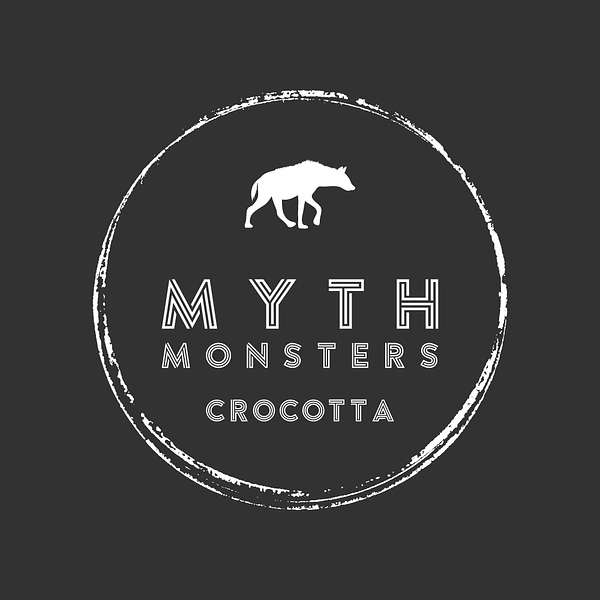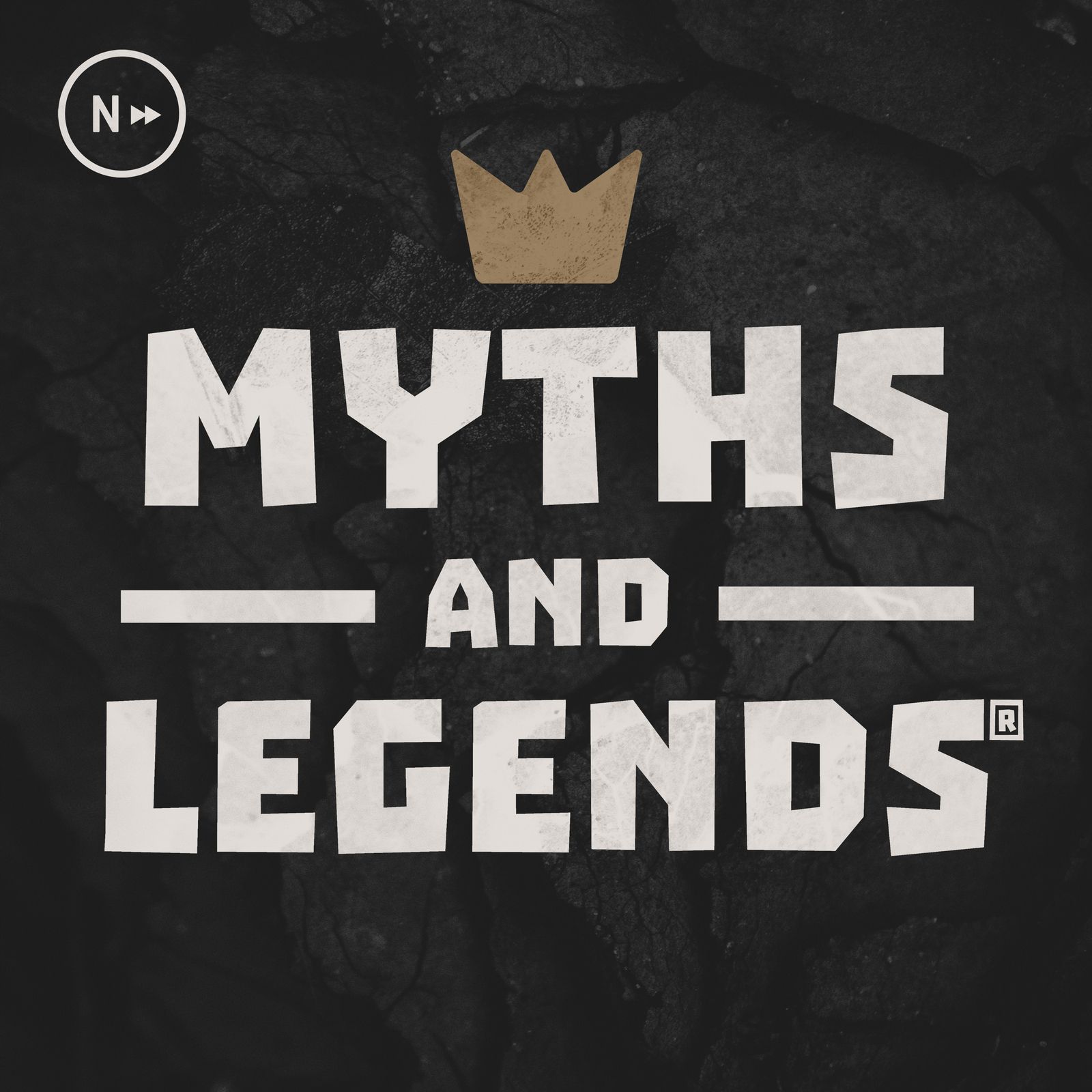
Myth Monsters
A bite sized look into the monsters of global folklore, cryptozoology and mythology with your host, Erin. Jump in and learn about your favourite monsters from Gorgons to Kelpies, to Wendigos to Bigfoot. Stay spooky every Thursday with a new episode with a new monster from another culture. Get in touch on Twitter at @mythmonsterspod
Myth Monsters
Crocotta
For this week's episode, we're heading over to India and Ethiopia for the horrible Crocotta! How does this monster relate to hyenas, wolves and dogs? How can you stop one from tempting you outside? Find out this week!
You can find us on:
Social media:
INTRO:
Hello and welcome to Myth Monsters, my name is Erin and I’ll be your host for these little snack bite size podcasts on folklore and mythical monsters from around the world.
These podcasts focus on the actual cryptids, folklore and mythic monsters from global mythology, rather than focusing on full stories of heroes and their big adventures.
I’ll also be dropping in some references that they have to recent culture and where you can see these represented in modern day content so you can learn more, and get as obsessed as I am about these absolute legends of the mythological world.
I spoke last week about how jetlagged I was, but this was written in advance of the jetlag and now I am in its fiery grip, I feel like I have been hit by a bus and haven’t slept for 6000 years so please do forgive my lack of interaction on social media this week!
DESCRIPTION:
Moving onto our episode for this week though, we’re zooming over to India and Ethiopia, which does seem like a strange combination for this monster - we are looking at the horrible and eerie Crocotta this week.
The Crocotta is generally described as a large dog and wolf hybrid, with more hyena features in its face. They can be as large as donkeys, and sometimes are described as having cloven hooves and a horse-like mane. They have bushy tails, with various colour fur, usually a mottled yellow or orange, but sometimes more of a black-brown, although it can also have spots or stripes. They are usually depicted as having large cat-like fangs and claws, but are often not seen by humans - when they are, they are most reported to look like hyenas.
This monster tends to live in rainforest caves or abandoned buildings, however, are known to live in most climates or terrain - they just need to make sure that they are around lots of food. They are carnivores and are known to eat anything, including humans, but seem to be content eating any kind of meat around. They are usually keen on cows, sheep or deer but again, are willing to eat humans, but of course it’s more effort. They are most found in India, as well as some countries in Africa, but are most likely found within Ethiopia, which is Eastern Africa.
How do they manage to get humans down? Well this is where their powers come in. The Crocotta are mimicking monsters, meaning that like parrots, they will mimic human speech - pretending to be a person in trouble in order to lure their prey out into the open. They are said to also be telepathic, as they are able to identify the prey and call out to them by name and using a relative's voice to entice them. Once the person has left the comfort of their house or safe place, the Crocotta would pounce and tear them apart with their claws and teeth, but they are a large creature, so resisting them at this point is almost futile. They won’t make extra effort to get humans over any other food source though, so you’re safe if you live on a farm for example.
The Crocotta is probably the most dangerous because it has an unending appetite, it’s said that they have an incredibly fast digestive system and so are always hungry and constantly trying to find prey. They’re also incredibly strong and will wait for food for up to 4 days, so they’re certainly not to be messed with.
Is there a way to kill them? Yes, but it’s difficult. They are somehow resistant to most weapons and damage of any kind, therefore it’s been difficult to track or capture one of these monsters, let alone kill one. You can get through to them if you just keep hacking or shooting at it, but they are considerably resistant, more so than usual animals.
The best way to avoid being killed by one is to just ignore their call if you know that the person they are mimicking could not possibly be outside or there are suspected Crocotta in the area. They are considered pack animals, much like hyena, wild dogs and wolves - however, these would usually consist of about 4 beasts. You can also try to outsmart them, if you feign an injury you can confuse a Crocotta, who is used to having to work for their food, and it’ll disrupt their attack long enough for you to get away.
Whilst we don’t have information on their breeding, we assume their lives are very much like these known animals, and most likely have a lifespan of around 12-15 years, giving birth to litters of pups and are mammalian, which if you didn’t know - means that they breastfeed and give birth to live young, much like us as humans, but a whole load of other animals. However, a fun twist on this, is that they are genderless beings, and are able to switch sexes at will - which does make the breeding idea interesting in comparison to other chosen hermaphrodite creatures such as snails, who can impregnate themselves.
ORIGIN:
Now onto etymology, the word Crocotta is actually Greek, and we believe it was borrowed from Sanskrit. This word doesn’t translate into English, but it is said to mean a beast mixed from wolf and dog. They do have some slight spelling variations, but there’s one variation leucrocotta - that is markedly different from the others and we’re not sure what the leu bit means I’m afraid.
For history, this one is interesting, because although these are Indian and Ethiopian monsters, they were first reported by Greek philosophers. The first mention was by Strabo, who mentioned the Crocotta as this wolf-dog mix all the way back in 44 BC in his Geographica, which was a collection of all of his knowledge on the world that he believed was just parts of whole continents that we know of now.
The biggest mention and still one of the oldest is by our beloved Pliny the Elder, if you’ve been listening to the podcast for a while - Pliny comes up a lot. He was a very famous Roman writer and philosopher, who wrote Natural History in 77 AD and this goes over pretty much every philosophical subject, including mythical beasts and real animals mistaken for them, all before his death in Pompeii in 79 AD when Mount Vesuvius erupted. He also called them a wolf-dog mix, but also a lion-hyena mix and described them as the following;
“When crossed with this race of animals the Ethiopian lioness gives birth to the corocotta, that mimics the voices of men and cattle in a similar way. It has an unbroken ridge of bone in each jaw, forming a continuous tooth without any gum.”
However, Pliny considered the leucrocotta and the Crocotta to be two different monsters and he described that as;
"the swiftest of all beasts, about the size of an ass, with a stag's haunches, a lion's neck, tail and breast, badger's head, cloven hoof, mouth opening right back to the ears, and ridges of bone in place of rows of teeth—this animal is reported to imitate the voices of human beings."
Although our sources tell us these are the same monster, Pliny was pretty dead set on them being very different indeed. After Pliny, there were Byzantine or modern day Turkish scholars who also investigated, including Photius, who, in the fifth century, said;
"In Ethiopia there is an animal called crocottas, vulgarly dog-wolf, of amazing strength. It is said to imitate the human voice, to call men by name at night, and to devour those who approach it. It is as brave as a lion, as swift as a horse, and as strong as a bull. It cannot be overcome by any weapon of steel."
Many other accounts followed from all over Europe and the Middle East up until the Middle Ages around 1300, where they were included in bestiaries in Scotland, England and Wales as well as across Europe. These monsters are still reported as being seen across India and Ethiopia, but also in the US - which is a much more recent discovery. The last known sighting of one was in 2008 in Texas, but they are few and far between in this part of the world.
In terms of what they could be, it is believed that the Crocotta is an early explanation of the Spotted Hyena. This is because they are immensely similar in their looks, but Hyenas are well known throughout different folktales to be mimics of human sounds with their distinctive laugh. As well as this, they are known to be scavengers and will wait for days without food - although they have attacked humans in the past, it is very rare. The only thing that may be in question is their location, whilst extremely common in Africa, including Ethiopia, they are not found in India - so it may be that this creature migrated or was wiped out within these regions. They even have an attributed Latin name to the Crocotta, Spotted Hyenas are called Crocuta crocuta in Latin as a tribute to their mythological counterpart - so there is not much debate here on what they might be.
For mythical comparisons, I can’t think of anything specific dog, wolf-like that matches the same behaviour or looks. But when we talk about Hyena monsters, we kind of have to talk about Gnolls. Gnolls are humanoid hyenas that are bloodthirsty cannibals and fighters, but able to don human armour and weaponry within their warbands to cause mayhem. Unfortunately, I do have to tell you that as much as we link Gnolls to folklore and as much as they fit in, they are fictional. They were created back in 1974 for the first ever Dungeons and Dragons set, but have been prevalent within modern media, especially video games such as World of Warcraft ever since. When I say Hogger, I hope a few of you know who I’m talking about. These monsters have sentient thought and are humanoid, so they are different to our monster as they can pre plan with thought - but they are worth the mention and I will probably cover them at some point for funsies.
But getting back to the Crocotta, we can also look at monsters that have the same mimicking behaviour to tempt humans in, I’m reminded of the Wendigo from Native American folklore which I covered not so long ago, but the idea that a monster can bring you in by mimicking your family is pretty scary. These monsters would call out in the dark woods and even could shapeshift into a loved one, then would tear you to shreds. Talking about them is pretty bad luck, so I’ll stop here.
CULTURAL SIGNIFICANCE:
Now onto modern media, I’m covering creepy hyenas today because there’s not much on Crocotta themselves but we all love an evil hyena.
For art, there are actually a load of old portraits for this one but they are all unnamed and just generic heraldry a lot of the time - so pop Crocotta into Google and you’ll see the older ones, they are pretty freaky though, just as a warning. Otherwise, there are some really cool independent art pieces with these in too!
In movies, we have; The Lion King, Birds of Prey and the Fantabulous Emancipation of One Harley Quinn, A Warrior’s Tale, The Lord of The Rings, Madagascar, The Lion, The Witch and the Wardrobe, Bedknobs and Broomsticks, Batman Beyond: Return of the Joker, Nosferatu, Duck Soup, The Jungle Book, Mowgli & Jumanji: The New Level.
For TV, we have; Harley Quinn, Gargoyles, Aggretsuko, Octonauts, Doraemon, One Piece, Talespin, Chip and Potato, The Batman, Killing Bites, The Jungle Book, Buffy the Vampire Slayer, Jungle Cubs, The New Adventures of Batman, Sonic The Hedgehog, The Wild Thornberrys & The Lion Guard.
In video games, we have ones such as; League of Legends, Dragon Age: Inquisition, Kingdom Rush, Warframe, Pokemon, Warcraft, World of Warcraft, Baldur’s Gate 3, EXTRAPOWER: Giant Fist, BUCK: Saturday Morning Cartoon Apocalypse, The Lion King, Assassin’s Creed Origins, Injustice 2 & Songs of Conquest.
My book recommendation this week is Indian Myths & Legends: Tales of Heroes, Gods & Monsters by J.K. Jackson and Dr Raj Balkaran for a great load of tales from Indian folklore, but if you wanted to look more at Ethiopian folklore, I’d recommend Tales of East Africa by Jamilla Okubo for some great stories from this part of the African continent.
DO I THINK THEY EXISTED?
Now it’s time for, do I think they existed?
I’m going to say yes and no here, because they are very clearly real. But the question is if I think the Crocotta exists, and that’s a no - do I believe that the Crocotta is a Spotted Hyena? Yes, yes I do. Hyenas are scary, they’re bigger than most dog-like animals, and they do look like wild dogs, so I understand why there would be folklore around them when they are usually bloody and laughing out in the Savannah.
But that’s about it in terms of existence I think at least - whilst the Crocotta sounds terrifying, Hyenas are generally very wary of people, but would definitely eat you if you were already dead or on your way out of this mortal coil we call life. They’re intimidating within their packs too, so I totally understand why this has come around.
It seems to me like this myth started as a way of protecting people from being around packs of Hyenas, especially with younger children or vulnerable people, as they will just wait for you to die, and are known to disturb graves to eat corpses too. In reality, this monster seems to be more of a desperate scavenger in a hotter, more stressful part of the world to hunt in.
But what do you think? Did the Crocotta roam the Indian rainforests? Let me know on Twitter!
OUTRO:
A different monster this week - and certainly one I didn’t think I would find as interesting as it is. I’m really glad we got to cover this one and I love heading over to this side of the world for a much lesser known mythology.
Next week, we’re heading over to the Greeks and looking at a fearsome group of lady monsters, or are they goddesses? We’ll find out next Thursday, but prepare your whips for punishment from the Erinyes! Yes, they are my namesake and I am very excited!
For now, thank you so much for listening, it’s been an absolute pleasure. If you enjoyed this podcast, please give it a rating on the service you’re listening on - I’ve got the twitter for any questions, or suggestions on what monsters to cover next and I’d love to hear from you. The social media handles for Tiktok, Youtube, Threads and Instagram are mythmonsterspodcast, and twitter is mythmonsterspod. But all of our content can be found at mythmonsters.co.uk - you can also find us on Goodpods, Buymeacoffee and Patreon if you want to help me fund the podcast too.
Come join the fun though and share this with your pals, they might love me as much as you do.
But for now, stay spooky and I’ll see you later babes.
Podcasts we love
Check out these other fine podcasts recommended by us, not an algorithm.

FolkLands
Tim Downie, Justin Chubb
Chatsunami
Satsunami
The Howdy Beans Podcast!
Luke The Elder Bean!
My Brother, My Brother And Me
The McElroys
Myths and Legends
Jason Weiser, Carissa Weiser, Nextpod
Lore
Aaron Mahnke
Exploration: Dreamland
Exploration: Dreamland
The Neatcast
Jeremy, Zack, Mike
Effin' Cultured
Bobby, Griff, and The Rik
